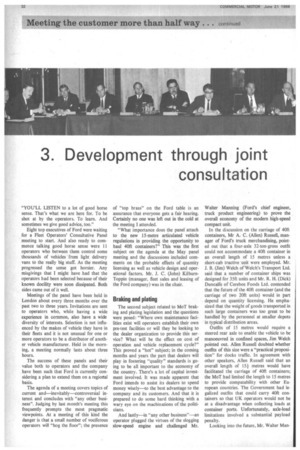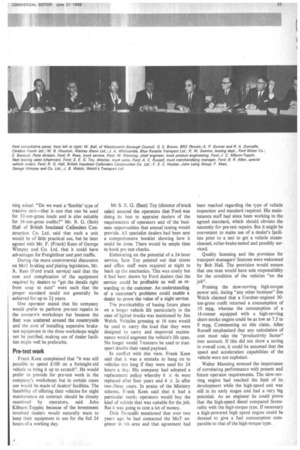3. Development through joint consultation
Page 34

Page 35

If you've noticed an error in this article please click here to report it so we can fix it.
"YOU'LL LISTEN to a lot of good horse sense. That's what we are here for. To be shot at by the operators. To learn. And sometimes we give good advice, too."
Eight top executives of Ford were waiting for a Fleet Operators' Consultative Panel meeting to start. And also ready to commence talking good horse sense were 11 operators who between them control some thousands of vehicles from light delivery vans to the really big stuff. As the meeting progressed the sense got horsier. Any misgivings that I might have had that the operators had been selected because of their known docility were soon dissipated. Both sides came out of it well.
Meetings of the panel have been held in London about every three months over the past two to three years. Invitations are sent to operators who, while having a wide experience in common, also have a wide diversity of interests. Selection is not influenced by the makes of vehicle they have in their fleets and it is not unusual for one or more operators to be a distributor of another vehicle manufacturer. Held in the morning, a meeting normally lasts about three hours.
The success of these panels and their value both to operators and the company have been such that Ford is currently considering a plan to extend them on a regional basis.
The agenda of a meeting covers topics of current and—inevitably—controversial interest and concludes with "any other business". Judging by last month's meeting this frequently prompts the most pragmatic viewpoints At a meeting of this kind the danger is that a small number of vociferous operators will "hog the floor"; the presence of "top brass" on the Ford table is an assurance that everyone gets a fair hearing. Certainly no one was left out in the cold at the meeting I attended.
"What importance does the panel attach to the new 15-metre articulated vehicle regulations in providing the opportunity to haul 4011 containers?" This was the first subject on the agenda at the May panel meeting and the discussions included comments on the probable effects of quantity licensing as well as vehicle design and operational factors. Mr. J. C. (John) KilburnToppin (manager, fleet sales and leasing of the Ford company) was in the chair.
Braking and plating
The second subject related to MoT braking and plating legislation and the questions were posed: "Where own maintenance facilities exist will operators establish their own pre-test facilities or will they be looking to the dealer organization to provide this service? What will be the effect on cost of operation and vehicle replacement cycle?" This proved a "hot" subject; in the coming months and years the part that dealers will play in fostering "quality" standards is going to be all important to the economy of the country. There's a lot of capital investment involved. It was made apparent that Ford intends to assist its dealers to spend money wisely—to the best advantage to the company and its customers. And that it is prepared to do some hard thinking with a wary eye on the machinations of the politicians.
And lastly—in "any other business"—an operator plugged the virtues of the slogging slow-speed engine and challenged Mr. Walter Manning (Ford's chief engineer, truck product engineering) to prove the overall economy of the modern high-speed compact unit.
In the discussion on the carriage of 40ft containers, Mr A. C. (Allen) Russell, manager of Ford's truck merchandising, pointed out that a four-axle 32-ton-gross outfit could not accommodate a 40ft container in an overall length of 15 metres unless a short-cab tractive 'unit were employed. Mr. J. B. (Jim) Welch of Welch's Transport Ltd. said that a number of container ships was designed for 35ft units and Mr. R. H. (Dick) Duncalfe of Cerebos Foods Ltd. contended that the future of the 40ft container (and the carriage of two 20ft units) would in part depend on quantity licensing. He emphasized that the weight of goods transported in such large containers was too great to be handled by the personnel at smaller depots in typical distribution areas.
Outfits of 15 metres would require a steered rear axle to enable the vehicle to be manoeuvred in confined spaces, Jim Welch pointed out. Allen Russell doubted whether outfits of this size were a "practical proposition" for docks traffic. In agreement with other speakers, Allen Russell said that an overall length of 151 metres would have facilitated the carriage of 4011 containers; the MoT had limited the length to 15 metres to provide compatability with other European countries. The Government had legalized outfits that could carry 40ft containers so that UK operators would not be at a disadvantage when collecting loads at container ports. Unfortunately, axle-load limitations involved a substantial payload penalty.
Looking into the future, Mr. Walter Man ning asked: "Do we want a 'flexible' type of tractive unit—that is one that can be used for 32-ton-gross loads and is also suitable for 16-ton-gross outfits?" Mr. R. G. (Bob) Hall of British Insulated Callenders Construction Co. Ltd. said that such a unit would be of little practical use, but he later agreed with Mr. F. (Frank) Keen of George Wimpey and Co. Ltd. that it could have advantages for Freightliner and port traffic.
• During the more controversial discussion on MoT braking and'plating legislation, Mr. R. Rees (Ford truck service) said that the cost and complication of the equipment required by dealers to "get the details right from soup to nuts" were such that the proper standard could not generally be achieved for up to 24 years.
One operator stated that his company would prefer to perform pre-test repairs in the concern's workshops but because the fleet was scattered around the countryside and the cost of installing expensive braketest equipment in the three workshops might not be justified, making use of dealer facilities might well be preferable.
Pro-test work
Frank Keen complained that "it was still possible to spend £.100 on a fortnight-old vehicle to bring it up to scratch". He would prefer to provide for pre-test work in the company's workshops but in certain cases use would be made of dealers' facilities. The feasibility of offering their vehicles for night maintenance on contract should be closely examined by operators, said John Kilburn-Toppin; because of the investment involved dealers would naturally want to keep their equipment in use for the full 24 hours of a working day. Mr S. E. G. (Sam) Toy (director of truck sales) assured the operators that Ford was doing its best to appraise dealers of the requirements of operators and of the business opportunities that annual testing would provide. All specialist dealers had been sent a comprehensive booklet showing how it could be done. There would be ample time to book pre-test checks.
Elaborating on the potential of a 24-hour service, Sam Toy pointed out that stores and office staff were required at night to back up the mechanics. This was costly but it had been shown by Ford dealers that the service could be profitable as well as rewarding to the customer. An understanding of a customer's problems could enable a dealer to prove the value of a night service.
The practicability of basing future plans on a longer vehicle life particularly in the case of lighter trucks was mentioned by Jim Welch. Vehicles grossing at 16 tons would be used to carry the load that they were designed to carry and improved maintenance would augment the vehicle's life span. No longer would 7-tonners be used to transport double their rated payload.
In conflict with this view, Frank Keen said that it was a mistake to hang on to vehicles too long if they were used for 24 hours a day. His company had adopted a replacement policy whereby 6 X 4s were replaced after four years and 4 X 2s after two /three years. In praise of the Ministry scheme, Frank Keen said that it had a particular merit; operators would buy the kind of vehicle that was suitable for the job. But it was going to cost a lot of money.
Dick Duncalfe mentioned that over two years ago he had contacted the MoT engineer in his area and that agreement had
been reached regarding the type of vehicle inspection and standard required. His maintenance staff had since been working to the agreed standard, which should obviate the necessity for pre-test repairs. But it might be convenient to make use of a dealer's ftacilities prior to a test to get a vehicle steamcleaned, roller-brake-tested and possibly serviced.
Quality licensing and the provision for transport managers' licences were welcomed by Bob Hall. The provision would ensure that one man would have sole responsibility for the condition of the vehicles "on the job".
Praising the slow-revving high-torque power unit, during "any other business" Jim Welch claimed that a Gardner-engined 30ton-gross outfit returned a consumption of 10 mpg, whereas the consumption of a 16-tonner equipped with a high-revving short-stroke engine could be as low as 7.5 to 8 mpg. Commenting on this claim, Allen Russell emphasized that any calculation of cost must take the "productivity factor" into account. If this did not show a saving in overall cost, it could be assumed that the speed and acceleration capabilities of the vehicle were not exploited.
Walter Manning stressed the importance of correlating performance with present and' future operator requirements. The slow-revving engine had reached the limit of its development while the high-speed unit was still in its early stages and had a very big potential. As an engineer he could prove that the high-speed diesel compared favourably with the high-torque type. If necessary a high-powered high speed engine could be derated to give a fuel consumption comparable to that of the high-torque type.








































































































































































































